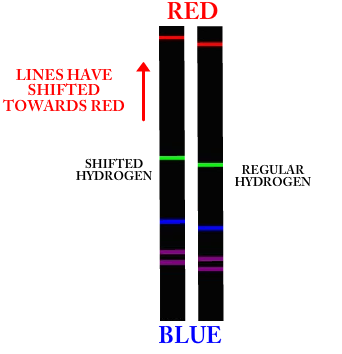

We learned earlier that different colors of light have different wavelengths. Red light has the longest waves and violet and blue light have the shortest waves.
If a star is moving towards the Earth (or away) it alters the wavelength slightly. Let's see why. In the picture below light is shining from a star towards the Earth. Drag the star towards the Earth (and away) and watch what happens.



What happened to the wavelength while you were dragging the star towards the Earth?
The wavelength increased. (Waves got longer.)
The wavelength decreased. (Waves got shorter.)
The wavelength was not affected. (Waves stayed the same.)
Try to explain why this is happening. (What is making the wave crests get closer together?)
What happened to the wavelength while you were dragging the star away from the Earth?
The wavelength increased. (Waves got longer.)
The wavelength decreased. (Waves got shorter.)
The wavelength was not affected. (Waves stayed the same.)
Try to explain why this is happening. (What is making the wave crests get further apart?)
Because the wavelength is changing, the colors in the starlight are changing too. The difference is so small that human eyes can't detect it. But a spectrometer can. The change in wavelength is called "shift" and there are two categories.
| RED SHIFT: | Remember that red light has the longest waves. If a star is moving away from the Earth it stretches the waves longer than they used to be. So we call it red shift. |
| BLUE SHIFT: | Remember that blue light has very short waves. If a star is moving towards the Earth it squishes the waves closer than they used to be. So we call it blue shift. |
| IMPORTANT: | Red shift does NOT mean that a star "looks red" and blue shift does NOT mean that a star "looks blue." |
The change in color is so small that you need a spectrometer to help you see it. The picture below shows an example of red shift.

The stripes on the second band show the regular emission spectrum of hydrogen. The stripes on the first band show light that has been red shifted. Notice that it still has all of the color bands that are associated with hydrogen. They have just shifted up towards the top a little bit. Because the color red is located near the top, we call this red shift;
Remember that red shift occurs when a star moves away from the Earth. Because the star is moving away the waves get stretched further apart.

The picture on the right shows a shift in the other direction. Notice that the hydrogen stripes have shifted down just a little bit towards the bottom. Because the color blue is located near the bottom, we call this blue shift.
Remember that blue shift occurs when a star moves towards the Earth. Because the star is coming closer the waves get squished closer together.
In the activity below each star has an emission spectrum for only one element. You need to identify
To make the comparison easier, a dotted line has been drawn under each star's emission spectrum. Make sure you line the bottom of your element up with this dotted line before you decide on which shift has occurred.
IMPORTANT: Remember you are looking to see which direction the stripes on the star have shifted.


| STEP 1: | Drag the red circle to the star you wish to analyze. |
| STEP 2: | The light from your star passes through the telescope into a spectrometer that shows you an emission spectrum. |
| STEP 3: | Compare the emission spectrum with the known elements to determine what the star is made out of. (To make this easier, the named elements can be dragged and lined up with the star's emission spectrum.) |
EMISSION SPECTRUM
DRAG ME NEXT TO EMISSION SPECTRUM TO COMPARE SPECTRAL LINES



| Element | Shift | Direction | |||||||||
| Helium | Hydrogen | Neon | Red | None | Blue | Away | Neither | Toward | |||
| Star 1 | |||||||||||
| Star 2 | |||||||||||
| Star 3 | |||||||||||
| Star 4 | |||||||||||
| Star 5 | |||||||||||
| Star 6 | |||||||||||
| Star 7 | |||||||||||